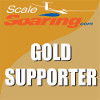Having just completed four days of aerotowing in Delaware at the Silent Knights SS GAAT event, I would like to share my experiences flying a TopModel Bidule 55 on tow and in the pits.
The plane came to me second hand and crashed but with a rich-running and very clean DLE 60 flat twin gas engine. Since I received the plane with no nose gear a new one was easily made in my garage and with the capacity for appropriately sized Dubro lighweight wheels. 4-1/2" dia in the nose and 5" main.
In all respects the plane lives up to expectations: the flying is deterministic and stable. Landings are flat and smooth with pronounced ground gradient lift bloom.
The biggest liability the plane has is that it does not fly a 170cc engine as its older siblings, and the diminutive stature in the presence 5M sailplanes and bigger tugs does not engender confidence in the glider line. Many glider pilots (perhaps with cause) turned down a four-five turn tow to wait for the big guns --ZDZ and DA equipped tugs with massive HP-- who could tow the same planes to the cloud base in three legs. Particularly obvious in this group were 1000 hour build planes and super scale planes where the model was too precious to risk an actual scale tow. Makes sense too, yet when confident glider pilots stepped up, so did the '55.
In one instance one of the more dedicated builders took a test tow with a 50 pound 7M ship. The consensus was that the Bidule 55 could get it in the air albeit in a very scale rate of climb, introducing more turns and time on tow--risky but okay in the hands of the plane's own maker/s.
Tow incidence ranged from 20-70 degrees off horizon on ships going from 25 pounds down to nearly weightless. Several 3D type tows were performed as one turn (downwind and upwind leg at release) jobs.
The plane scares pilots because unburdened with a tow it flies fast and my particular plane is set up with tons of surface control authority. The biggest indicator is its ability to flip from knife edge to knife edge fast as one would expect from a true pattern ship. Definitely not a friend building display at a glider field.
The Bidule is the first plane I've owned that was not buil from scratch or a kit. In mounting the hardware for the engine it is clear that the ply quality is marginal and in my repairs I noted a lot of unbonded glue. Factory covering is impeccable and takes removal, replacing, and reshrinking very well.
More to follow.
The plane came to me second hand and crashed but with a rich-running and very clean DLE 60 flat twin gas engine. Since I received the plane with no nose gear a new one was easily made in my garage and with the capacity for appropriately sized Dubro lighweight wheels. 4-1/2" dia in the nose and 5" main.
In all respects the plane lives up to expectations: the flying is deterministic and stable. Landings are flat and smooth with pronounced ground gradient lift bloom.
The biggest liability the plane has is that it does not fly a 170cc engine as its older siblings, and the diminutive stature in the presence 5M sailplanes and bigger tugs does not engender confidence in the glider line. Many glider pilots (perhaps with cause) turned down a four-five turn tow to wait for the big guns --ZDZ and DA equipped tugs with massive HP-- who could tow the same planes to the cloud base in three legs. Particularly obvious in this group were 1000 hour build planes and super scale planes where the model was too precious to risk an actual scale tow. Makes sense too, yet when confident glider pilots stepped up, so did the '55.
In one instance one of the more dedicated builders took a test tow with a 50 pound 7M ship. The consensus was that the Bidule 55 could get it in the air albeit in a very scale rate of climb, introducing more turns and time on tow--risky but okay in the hands of the plane's own maker/s.
Tow incidence ranged from 20-70 degrees off horizon on ships going from 25 pounds down to nearly weightless. Several 3D type tows were performed as one turn (downwind and upwind leg at release) jobs.
The plane scares pilots because unburdened with a tow it flies fast and my particular plane is set up with tons of surface control authority. The biggest indicator is its ability to flip from knife edge to knife edge fast as one would expect from a true pattern ship. Definitely not a friend building display at a glider field.
The Bidule is the first plane I've owned that was not buil from scratch or a kit. In mounting the hardware for the engine it is clear that the ply quality is marginal and in my repairs I noted a lot of unbonded glue. Factory covering is impeccable and takes removal, replacing, and reshrinking very well.
More to follow.



Comment